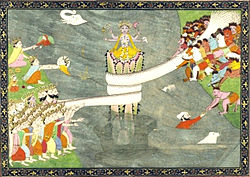In Hinduism, Samudra manthan or Ksheera Sagara Mathanam, Churning of the ocean of milk is one of the most famous episodes in the Puranas and is celebrated in a major way every twelve years in the festival known as Kumbha Mela. The story appears in the Bhagavata Purana, the Mahabharata and the Vishnu Purana. The location of this event is popularly believed to be Antarvedi in modern day Andhra Pradesh.
Samudra Manthan is also known as —
 In battles that followed this incident, Devas were defeated and Asuras (demons) led by king Bali gained control of the universe. Devas sought help from god Vishnu who advised them to treat asuras in a diplomatic manner. Devas formed an alliance with asuras to jointly churn the ocean for the nectar of immortality and to share it among them. However, Lord Vishnu told Devas that he would arrange that they alone obtain the nectar.
In battles that followed this incident, Devas were defeated and Asuras (demons) led by king Bali gained control of the universe. Devas sought help from god Vishnu who advised them to treat asuras in a diplomatic manner. Devas formed an alliance with asuras to jointly churn the ocean for the nectar of immortality and to share it among them. However, Lord Vishnu told Devas that he would arrange that they alone obtain the nectar.
Samudra Manthan is also known as —
- Samudra manthanam — Manthanam is the Sanskrit equivalent of Manthan meaning 'to churn'.
- Sagar manthan — Sagar is another word for Samudra, both meaning an ocean or large water body.
- Kshirsagar manthan — Kshirsagar means the ocean of milk. Kshirsagar = Kshir (milk) + Sagar (ocean).
Kurma, avatar of Vishnu, below Mount Mandara, with Vasuki wrapped around it, during Samudra manthan, the churning of the ocean of milk, ca 1870.
[edit] Churning the Milky Ocean
The churning of the Ocean of Milk was an elaborate process. Mount Mandaranchal was used as the dasher (churning tool), and Vasuki, the king of serpents, became the churning rope. The gods held the tail of the snake, while the demons (Asuras) held its head, and they pulled on it alternately causing the mountain to rotate, which in turn churned the ocean. However, once the mountain was placed on the ocean, it began to sink. Vishnu in his second incarnation, in the form of a turtle Kurma, came to their rescue and supported the mountain on his back.[edit] Halahala (Also called 'kalakuta')
During the Samudra Manthan by the gods and demons, one of the product emerged from the churning was a dangerous poison (Halahala). This terrified the gods and demons because the poison was so toxic that it might have destroyed all of creation. On the advice of Vishnu, the gods approached Shiva for help and protection. Out of compassion for living beings, Shiva swallowed the poison in an act of self-sacrifice. However, his consort Parvati who was looking on, terrified at the thought of his impending death, squeezed his throat to prevent the poison descending into his body. Thus the poison was stuck in Shiva's throat with nowhere to go, and it was so potent that it changed the color of Shiva's neck to blue. For this reason, he is also called Neelakantha (the blue-throated one; "neela" = "blue", "kantha" = "throat" in Sanskrit).[edit] Ratnas
All kinds of herbs were cast into the ocean and fourteen Ratnas (gems or treasures) were produced from the ocean and were divided between asuras and gods. Though usually the Ratnas are enumerated as 14, the list in the scriptures ranges from 9 to 14 Ratnas. Most lists include:[1]- Halahala, the poison swallowed by Shiva
- Varuni or Sura, goddess and creator of alcohol. As she was accepted by the gods, they are called as Suras, while the demons - Asuras.
- Uchhaishravas, the divine 7-headed horse
- Kaustubha, the most valuable jewel in the world, worn by Vishnu
- Chandra, the moon
- Lakshmi, the Goddess of Fortune and Wealth -Vishnu's consort
- Apsaras, various divine nymphs like Rambha, Menaka, Punjikasthala, etc.
- Kamadhenu or Surabhi, the wish-granting divine cow
- Parijat, the divine flowering tree with blossoms that never fade or wilt, identified with Kalpavriksha, the wish-granting tree
- Airavata, the elephant of Indra
- Dhanvantari, the doctor of the gods with Amrita the nectar of immortality. (At times, considered as two different Ratnas)


No comments:
Post a Comment